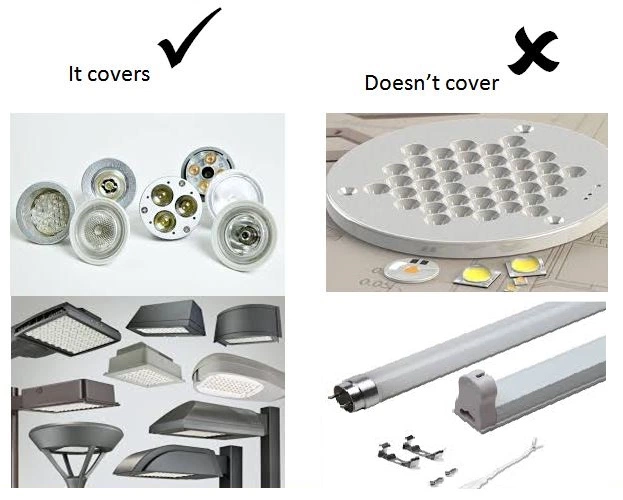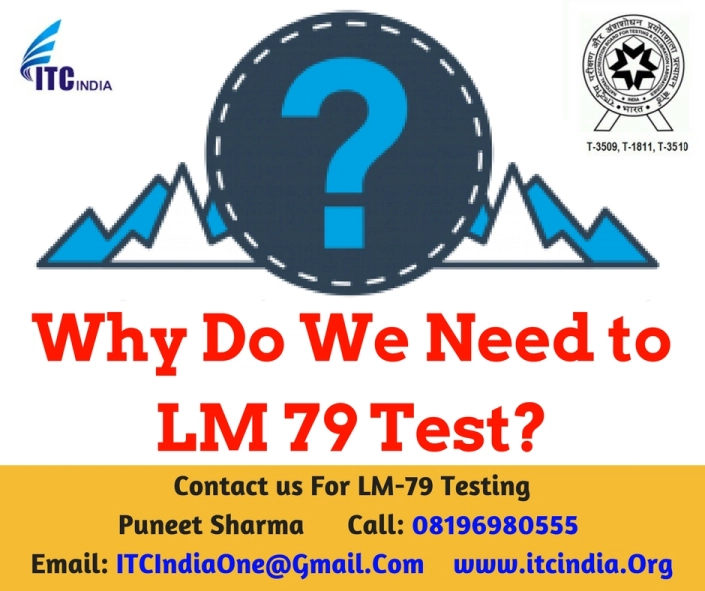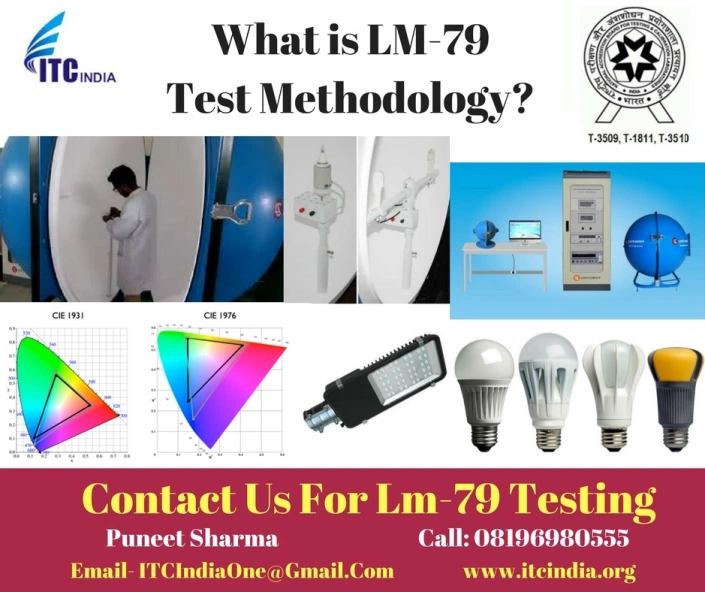Solutions for LM-79
Why Do We Need to LM 79 Test?
Why Do We Need to LM 79 Test?
LED is becoming so popular that it has replaced all other lightning sources like candescent lamp, CFL. Manufacturer have shifted to produce LED and making profits by selling low quality products in the market. This can deteriorate the LED business. LM 79 helps to access the LED by giving the photometric parameters and electrical parameters.
LM 79 focus on the absolute photometry, so it directly measures the total lumen of the complete lightning system including fixture, driver etc. LM 79 test report gives electrical and photometric parameter.
Photometric parameter: Luminous flux (lm), efficacy (lm/w), Luminous intensity distribution (candela), chromaticity coordinates, correlated color temperature (CCT), color rendering index (CRI)
Electrical parameter: voltage, current, frequency, power, power factor.
LM 79 Data enable objective product comparison and allows for evaluation relative to performance requirement.
If you’re Buyers Demanding for LM-79 Testing– Contact Now!
Wish this blog post will be help. If you have any other questions, please feel free to contact us. ITCIndia team looking forward work with you and get better together!
Mr. Puneet Sharma | Call: 08196980555 | E-mail: [email protected]
Get Instant Quotations, Fill the Enquiry form:
This entry was posted in LED Testing, LM 79 Testing and tagged Electrical Safety testing lab near me, Electrical Testing Laboratories near me, How LM-79 testing can help assess LED, LED Luminaire Testing to Include LM-79 ..., LED Luminaire Tests LM-79 - NABLCertified Testing Lab near me, LED Testing Lab Near me, LM 79 Test Laboratory near me, lm 79 testing lab near me, lm 79 testing labs near me, LM-79 Testing near me, LM-79 Testing service Near me, luminaire testing lab near me, luminaire testing laboratory near me, Luminaire Testing near me, Photometric Testing Lab Near me, Photometric Testing service Near me, Solutions for LM-79, Why Do We Need to LM 79 Test?.
What is LM 79 Test methodology?
What is LM 79 Test methodology?
LM 79 is an approved method that describes the procedure to be followed and precautions to be observed in performing reproducible measurements of total Luminous flux, electrical power, luminous intensity distribution, chromaticity of Solid-State lighting products for illumination purposes under standard conditions.
LM 79 covers- LED based SSL products with control electronics and heat sinks. Luminaries (fixtures incorporating light source) as well integrated LED lamps.
LM 79 doesn’t cover– fixtures without a light source, SSL products that require external operating.
LM 79

Test method for total luminous flux Measurements:
The total luminous flux of SSL product shall be measured with an Integrating Sphere or Goniophotometer. The method may be chosen depending upon what other measurements quantities (color, intensity distribution) need to be measured., the size of SSL products, and other requirements.
The integrating sphere is suited for total luminous flux and color measurements of integrated LED lamps and relative small size LED luminaries. Advantage of using integrating sphere is that it does not requires the “ Dark Room”., and also it is less time consuming.
The Goniophotometer provides measurements of Luminous Intensity Distribution as well as total luminous flux. It can take measurements of larger size luminaries as well as small size luminaries. It has to be installed in Dark Room. Measurements in goniophotometer are time consuming.
| Integrating Sphere | Goniophotometer | |
| Conditions | No Dark room | Dark Room |
| Size of SSL | Small Size luminaries | Large size as well as small size Luminaries |
| Measurements | Total Luminous Flux | Light Intensity Distribution , Total Luminous Flux |
| Duration of Test | Fast Measurements | Time consuming as compared to Sphere photometer. |
If you’re Buyers Demanding for Luminaries Testing– Contact Now!
Wish this blog post will be help. If you have any other questions, please feel free to contact us. ITCIndia team looking forward work with you and get better together!
Mr. Puneet Sharma | Call: 08196980555 | E-mail: [email protected]
Get Instant Quotations, Fill the Enquiry form:
This entry was posted in LED Bulb Testing, LED Testing, LM 79 Testing, LM-79 Testing | LM-79 Test Approved Methods and tagged 80 and other LED Standards, CCT and power factor . Contact us Now, CRI, Electrical and Photometric tests as required, esting efficient luminaires and LED retrofit lamps, How to check in LM-79, ies lm-80, IESNA LM-79-2008 Approved method, Instrument solutions for lm-79, istmt, LED and Lighting Testing Specialists, led driver testing equipment, led lamp testing equipment, led light testing equipment in india, led light testing procedure, LED Lighting Facts® LED Lumen Maintenance and Warranty Label, led lighting standards testing and certification, LED Luminaire Lifetime: Recommendations for Testing and Reporting, LED Luminaires Lamps Testing, led test blood, LED test labs for LED life testing, LED testing and LED test services for light measurement, led testing device, led testing standards, LED Testing Standards Overview, LID, light measurement and reliability, list of approved testing laboratories in india for LM-79, list of approved testing labs in india for LM-79, list of labs under lm-79, list of testing laboratories in india for LM-79, Lm 79, lm 79 80 standards, LM 79 Test Laboratory - LED/SSL Luminaires, LM 79 testing by NABL - Accredited lab in just 5 days, lm 79 testing labs in india, lm 80 standard pdf, LM-79 & LM-80 | Decorative Outdoor Lighting, LM-79 LM-80 Technical Report - ITCIndia, LM-79 Test Labs, lm-79 test procedure, LM-79 Test Report, LM-79 test reports and luminaire LED quality and performance, LM-79 Testing - ITCINDIA, LM-79 testing laboratories, LM-79-08 - IES, lm-80, lm79, LM80, Lumens, making sense of led testing standards, NABL approved test labs for LM-79, need/requirement in LM-79, need/requirement in LM-79 Testing, need/requirement under LM-79, need/requirement under LM-79 Testing, Performance measurement of lamps and luminaires, performance testing of lighting products, performance testing of lighting products - ITCIndia, Photometric Measurement of LED Luminaires, Photometric Testing: Lamp - LED - Luminaire Testing, Production & Testing — LED professional - LED Lighting Technology, Quality LED Testing, sample lm79 report, Searches related to LED Luminaires Lamps Testing, Searches related to What is LM 79 Test methodology?, Solutions for LM-79, Sorting out LM 79, Testing Lab Requirements, Testing Methodology, tm 21, tm 21 led testing, TM21 and L70, Understanding IES LM-79 & IES LM-80, what are the Parameters Required under LM-79 testing, What is LM 79 Test methodology?, WHAT is LM-79 Testing, what to check in LM-79, who do LM-79 Tests/testing, Who will do testing in LM-79, Why testing is necessary under LM-79, Why to check in LM-79.
LM-79 Testing | LM-79 Test Approved Methods
LM-79 Testing | LM-79 Test Approved Methods
ITCIndia NABL Approved Electrical Safety Testing Laboratory, ITCIndia Laboratory is following the procedure as required by International Standard IEC 17025 and is already certified for ISO 17025 by NABL , has been awarded accreditation by the National Accreditation Board for Testing and Calibration Laboratories (NABL). Under the Energy Efficient Lighting Products Program. This includes LM-79 accreditation for Solid State Lighting Luminaires, Total Flux Measurements (Luminous Efficacy) & Solid State Lighting Luminaires, Luminous Intensity Measurements.
Definition of LM-79 Testing:
LM-79 is one approved method that describes procedures & precautions in performing measurement of LED products.
Scope of IES LM-79 testing:
LM-79 Testing is applied to solid-state lighting products that include the following requirements:
- LED based products that are integrated control circuit and heat sinks
- LED based products only requiring AC or DC power supply
And does not cover as bellow:
- LED products requiring external operating circuits or heat sinks (bare LED chips, package and modules)
- Fixtures designed for LED products but sold without a light source
Electrical Requirements:
- SSL products work with AC power: voltage, electrical current, power, frequency, power factor
- SSL products work with DC power: voltage, electrical current, power
Test Condition and Procedures/ LM-79 Procedures and Conditions:
-
Ambient Conditions
- Temperature–maintaining at 25℃±1℃ / Maintain temperature at 25 degrees C +/-1 degree C (within 1M)
- Air Flow—limited/ Limited air flow
- Mounting–limited thermal transfer
- Voltage regulation to +/- 2%
- Voltage waveform (harmonic distortion< 3%) / AC wave shape limit to harmonic RMS of 3%
-
Aging and Stabilization/ Seasoning and Stabilization
- New SSL products can be put into tested without aging.
- Before testing, SSL products should work for a certain time to reach up stable working temperature.
-
Working Orientation/ Testing Orientation
-
Electrical Settings
-
Instrumentation
Test Method of Lm-79/ LM-79 Test Methods:
Integrating Sphere and Goniophotometer available to achieve the test report
Integrating Sphere: Integrating sphere systems are used to measure the total luminous flux and color for LM-79. This can be performed with a photometer (total luminous flux) or a spectral radiometer (spectral radiant flux). Utilizing a spectral radiometer and integrating sphere is the preferred method, which derives total luminous flux and color qualities form spectral radiant flux measurements. Click here to see (Video) how to do LM-79 Test with Integrating sphere systems
- For measuring total luminous flux and color
- Photometer – Total Luminous Flux
- Spectral Radiometer (preferred) – Spectral Radiant
- Flux (to derive total luminous flux and color qualities)
Goniophometer : Goniophotometer systems are also used for LM-79 testing to measure luminous intensity distribution. The Goniophotometer system tests derive total luminous flux and provide color characteristics including CCT and CRI.
- For measuring luminous intensity distribution
- Total luminous flux is derived
- Provides color characteristics with spectral radiometer including CCT, CRI
Testing Data of IES LM-79/ LM-79 Test Outputs and Calculations:
Photometric Requirements:
- Total Luminous Flux
- Luminous Intensity Distribution
- Electrical Power
- Luminous Efficacy(lm/w)
- Light Intensity Distribution
- Chromaticity
- CCT
- CRI
If you are Interested You can Fill out the form below to receive a quote on the LM-79 Testing to get started:
Contact Now!
Puneet Sharma
M: 08196980555 E: [email protected]
This entry was posted in LM 79 Tesing For Street Light As Per IEC 60598-2-3, LM 79 Testing, LM-79 Testing Ahmedabad, LM-79 Testing on High bay LED lights, LM-79 testing on High Power LED Light Model, LM-79 Testing | LM-79 Test Approved Methods and tagged 30W Led Street Light LM79 Test Report, Aging and Stabilization/ Seasoning and Stabilization, Ambient Conditions, And does not cover as bellow:, Definition of IES LM-79 Testing:, Definition of LM-79 Testing:, Electrical Requirements:, Electrical Settings, Fast LM 79 Testing Report, Get LM 79 Testing Info, Goniophotometer, Haryana, How to do LM-79 Testing?, ies lm-79, India, Instrumentation, Integrating Sphere, ITCIndia providing LM-79 testing in a NABL accredited laboratory for Solid State Lighting Luminaires and LEDs., LED Lighting & LM-79 Luminaire Testing Laboratory in India, LED Lighting Facts Approved Labs List, LED Luminaire Testing, LED Product LM-79 Testing lab in India Mumbai, led testing labs in india, LM 79 Test Laboratory - LED/SSL Luminaires call 8196980555, lm 79 testing Ambala, LM 79 Testing Approved Method, LM 79 Testing at ITCindia, lm 79 testing Chennai tamil nadu, LM 79 testing for LED product Offered by Itc India Pvt Ltd, lm 79 testing Gujarat, lm 79 testing gurgaon haryana, lm 79 testing kolkata west bangal, lm 79 testing labs, lm 79 testing labs in bangalore, lm 79 testing maharashtra, lm 79 testing New Delhi, lm 79 testing Noida, LM-79 Definition and Scope: The scope of how LM 79 applies to LED-based products which incorporate control electronics and heat sinks, lm-79 standard, lm-79 test procedure, LM-79 Test Report, Lm-79 Test Report In 2 Days, Lm-79 testing Ahmedabad, LM-79 Testing for LED Street Light, LM-79 Testing In India, Lm-79 testing India, LM-79 Testing Laboratory, Lm-79 testing Mumbai, LM-79 testing on High Power LED Light Model, Lm-79 testing Pune, LM-79 Testing | LM-79 Test Approved Methods, NABL Accredited Laboratory India, Panchkula, Power Supply, Relative vs. Absolute Photometry, Scope of IES LM-79 testing:, Searches related to LM-79 Testing In India, Solutions for LM-79, Test Condition and Procedures/ LM-79 Procedures and Conditions:, Test Method of Lm-79/ LM-79 Test Methods:, Understanding LM-79 Reports, What LM 79 does cover?, What LM 79 does not cover?, Working Orientation/ Testing Orientation.
LM 79 testing on led products
LM 79 Testing Service on led products in India, Mumbai, Chennai, Ahmedabad, Delhi, Pune
If you are looking for Lm-79 testing laboratory in your Area. ITC India Nabl Accredited Laboratory can do Test your led light for luminous flux , CCT , CRI , Efficacy , charomaticity diagram, voltage , current , power , power factor, etc..
Puneet Sharma | 08196980555 | [email protected]
Submit Your Testing Requirements,Please fill out the Enquiry below:
This entry was posted in LM 79 Testing and tagged Electrical & Electronic Safety Testing Laboratory, Electrical Safety Testing Services & Luminaire Testing, Electrical Testing Service - LM 79, Get LM-79 test report in 2 Days in Ahmedabad, Get LM-79 test report in 2 Days in Chennai, Get LM-79 test report in 2 Days in Delhi, Get LM-79 test report in 2 Days in India, Get LM-79 test report in 2 Days in Ludhiana, Get LM-79 test report in 2 Days in Mumbai, Ip Testing Laboratory: Services, Lamps & Luminaires - EMC-EMI Testing lab in Delhi | LED, Led Lighting, LED Lighting Facts Approved Labs List, Lm 79, Lm 79 testing service provider in India, LM-79 Reports, Lm-79 testing Ahmedabad, Lm-79 testing Chennai, Lm-79 testing Delhi, Lm-79 testing India, lm-79 testing lab, Lm-79 testing lab in Ahmedabad, Lm-79 testing lab in Chennai, Lm-79 testing lab in Delhi, Lm-79 testing lab in India, Lm-79 testing lab in Mumbai, Lm-79 testing lab in Pune, LM-79 Testing Laboratory in Ahmedabad, LM-79 Testing Laboratory in Chennai, LM-79 Testing Laboratory in Delhi, LM-79 Testing Laboratory in India, LM-79 Testing Laboratory in Ludhiana, LM-79 Testing Laboratory in Mumbai, LM-79 Testing Laboratory in panchkula, Lm-79 testing Mumbai, Lm-79 testing Pune, Lm-79 testing service Ahmedabad, Lm-79 testing service Chennai, Lm-79 testing service Delhi, Lm-79 testing service India, Lm-79 testing service Mumbai, Lm-79 testing service Pune, LM-79 Testing | Itc India, lm79 report, Solutions for LM-79, Testing Laboratory.

